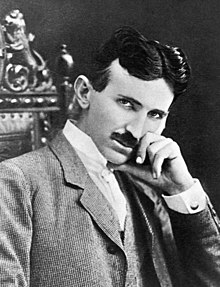Nikola Tesla
May 25, 2019 • 2 views
Nikola Tesla

c. 1896
Born
10 July 1856
Smiljan,Austrian Empire(modern-dayCroatia)
Died
7 January 1943(aged86)
New York City, United States
Resting place
Nikola Tesla Museum,Belgrade,Serbia
Citizenship
Austrian (1856–1891)
American(1891–1943)
Education
Graz University of Technology(dropped out)
Engineering career
Discipline
Electrical engineering,
Mechanical engineering
Projects
high-voltage, high-frequency power experiments
Significant design
Awards
Order of St. Sava, II Class, Government of Serbia (1892)
Elliott Cresson Medal(1894)
Order of Prince Danilo I(1895)
Edison Medal(1916)
Order of St. Sava, I Class, Government of Yugoslavia (1926)
John Scott Medal(1934)
Order of the White Eagle, I Class, Government of Yugoslavia (1936)
Order of the White Lion, I Class, Government of Czechoslovakia (1937)
University of Paris Medal (1937)
The Medal of the University St Clement of Ochrida,Sofia, Bulgaria(1939)
Signature

Born and raised in the Austrian Empire, Tesla received an advanced education in engineering and physics in the 1870s and gained practical experience in the early 1880s working intelephonyand at Continental Edison in the newelectric power industry. He emigrated in 1884 to the United States, where he would become a naturalized citizen. He worked for a short time at theEdison Machine Worksin New York City before he struck out on his own. With the help of partners to finance and market his ideas, Tesla set up laboratories and companies in New York to develop a range of electrical and mechanical devices. Hisalternating current(AC)induction motorand relatedpolyphaseAC patents, licensed byWestinghouse Electricin 1888, earned him a considerable amount of money and became the cornerstone of the polyphase system which that company would eventually market.
Attempting to develop inventions he could patent and market, Tesla conducted a range of experiments with mechanical oscillators/generators, electrical discharge tubes, and early X-ray imaging. He also built a wireless-controlled boat, one of the first ever exhibited. Tesla became well known as an inventor and would demonstrate his achievements to celebrities and wealthy patrons at his lab, and was noted for his showmanship at public lectures. Throughout the 1890s, Tesla pursued his ideas for wireless lighting and worldwide wireless electric power distribution in his high-voltage, high-frequency power experiments in New York andColorado Springs. In 1893, he made pronouncements on the possibility ofwireless communicationwith his devices. Tesla tried to put these ideas to practical use in his unfinishedWardenclyffe Towerproject, an intercontinental wireless communication and power transmitter, but ran out of funding before he could complete it.[7]
After Wardenclyffe, Tesla experimented with a series of inventions in the 1910s and 1920s with varying degrees of success. Having spent most of his money, Tesla lived in a series of New York hotels, leaving behind unpaid bills. He died in New York City in January 1943.[8]Tesla's work fell into relative obscurity following his death, until 1960, when theGeneral Conference on Weights and Measuresnamed theSI unitofmagnetic flux densitytheteslain his honor.[9]There has been a resurgence in popular interest in Tesla since the 1990s.[10]
